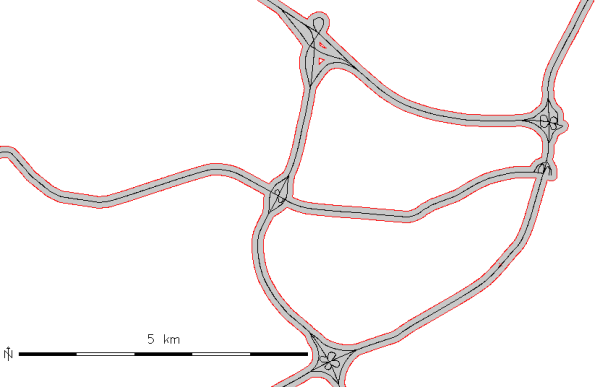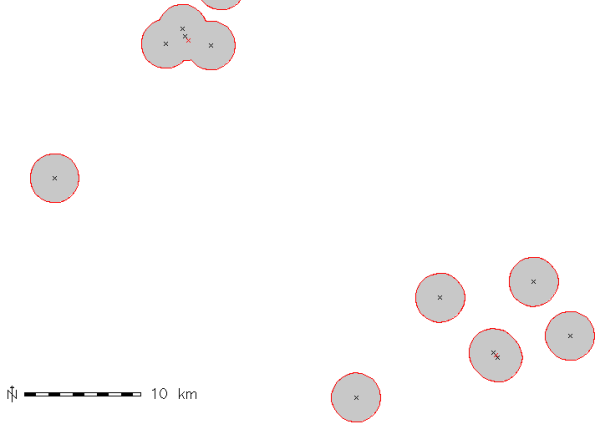
Note: A new GRASS GIS stable version has been released: GRASS GIS 7. Go directly to the new manual page here
NAME
v.buffer - Creates a buffer around vector features of given type.
KEYWORDS
vector, buffer, geometry
SYNOPSIS
v.buffer
v.buffer help
v.buffer [-sct] input=name [layer=integer] [cats=range] [where=sql_query] [type=string[,string,...]] output=name [distance=float] [minordistance=float] [angle=float] [bufcolumn=name] [scale=float] [tolerance=float] [--overwrite] [--verbose] [--quiet]
Flags:
- -s
- Make outside corners straight
- -c
- Don't make caps at the ends of polylines
- -t
- Transfer categories and attributes
- --overwrite
- Allow output files to overwrite existing files
- --verbose
- Verbose module output
- --quiet
- Quiet module output
Parameters:
- input=name
- Name of input vector map
- layer=integer
- Layer number
- A single vector map can be connected to multiple database tables. This number determines which table to use.
- Default: 1
- cats=range
- Category values
- Example: 1,3,7-9,13
- where=sql_query
- WHERE conditions of SQL statement without 'where' keyword
- Example: income < 1000 and inhab >= 10000
- type=string[,string,...]
- Feature type
- Options: point,line,boundary,centroid,area
- Default: point,line,area
- output=name
- Name for output vector map
- distance=float
- Buffer distance along major axis in map units
- minordistance=float
- Buffer distance along minor axis in map units
- angle=float
- Angle of major axis in degrees
- Default: 0
- bufcolumn=name
- Name of column to use for buffer distances
- scale=float
- Scaling factor for attribute column values
- Default: 1.0
- tolerance=float
- Maximum distance between theoretical arc and polygon segments as multiple of buffer
- Default: 0.01
DESCRIPTION
v.buffer creates a buffer around features of given type, which
have a category in the given layer. The tolerance controls
the number of vector segments being generated (the smaller the value, the more
vector segments are generated).
NOTES
Internal buffers for areas can be generated with negative distance
values ("inward buffer" or "negative buffer").
Attributes are not transferred due to potential buffer overlap, which
cannot be resolved automatically.
Buffers for lines and areas are generated using the algorithms from
the GEOS library.
EXAMPLES
All examples are based on the North Carolina sample dataset.
Buffer around input lines
v.buffer input=roadsmajor output=roadsmajor_buffer type=line distance=100

Buffer of 100m along the "roadsmajor" lines (map subset, original center line
shown in black)
Circles around input points
v.buffer input=hospitals output=hospitals_circled type=point distance=2000

Buffer of 2000m around the "hospitals" points (map subset, original points
shown in black, new area centroids in red)
Overlapping circles around input points with attribute transfer
# copy map to current mapset (for easier DB linking)
g.copy vect=hospitals,myhospitals
v.buffer input=myhospitals output=circles type=point distance=2000
# change original points to centroids:
v.type in=myhospitals out=hospital_centroids type=point,centroid
# patch circles and centroids:
v.patch in=hospital_centroids,circles out=circles_db
# attach attributes, either use db.copy or link to the original table:
v.db.connect map=circles_db table=myhospitals layer=1 key=cat driver=dbf \
database='$GISDBASE/$LOCATION_NAME/$MAPSET/dbf'
v.db.select circles_db
Buffer around input areas
v.buffer input=lakes output=lakes_buffer type=area distance=100

Buffer of 100m around the "lakes" polygons (map subset, original areas
shown in black)
REFERENCE
SEE ALSO
r.buffer,
v.parallel,
v.extract,
v.type,
v.patch,
v.db.connect
AUTHORS
Radim Blazek
Rewritten by Rosen Matev (with support through the
Google Summer of Code program 2008)
Rewritten by Markus Metz (2011, 2012)
Last changed: $Date: 2014-04-30 09:19:24 -0700 (Wed, 30 Apr 2014) $
Main index - vector index - Full index
© 2003-2016 GRASS Development Team




